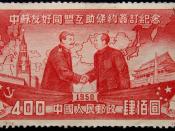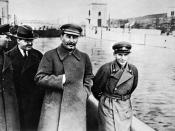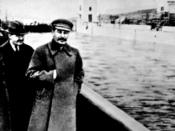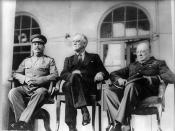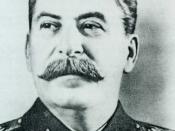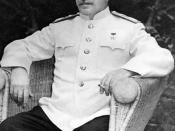Joseph Stalin (born 18 December 1878) was the General Secretary of the Communist Party of the Soviet Union's Central Committee from 1922 until his death in 1953. Stalin was the protégé of Lenin who has helped get him appointed as the General Secretary to help build a base against Trotsky. Trotsky's ideology was that of an orthodox Marxist who believed in a need for international proletarian revolution. Where as Stalinism was the idea of Socialism in one country.
However, as Stalin began approaching issues in a way that Lenin thought inappropriate the pair began to quarrel and their relationship deteriorated. Lenin dictated increasingly disparaging notes on Stalin in what would become his Testament. He criticized Stalin's rude manners, excessive power, ambition and politics, and suggested that Stalin should be removed from the position of General Secretary. However Stalin began creating alliances that were hidden from Lenin and when he died on the 24th of January, 1924 and his testament was revealed, Stalin was fortunate to be able to prevent it from being read at the Twelfth Party Congress in April 1923 .1928.
Stalin now in a seat of unattainable and unassailable power pushed for a rapid industrialization and the mass collectivization of the peasant farms.
"We must overtake and outstrip the advanced technology of the developed capitalist countries. We have overtaken and outstripped the advanced capitalist countries in the sense of establishing a new political system, the Soviet system. That is good. But it is not enough. In order to secure the final victory of socialism in our country, we must also overtake and outstrip these countries technically and economically. Either we do this, or we shall be forced to the wall"Stalin believed that Industry had to be rapidly modernized and the way to achieving this was through the mechanization of agriculture which would supply the base supplies that would be needed to support the explosive growth of industrial cities that Stalin envisioned.
The Communist regime believed that collectivization would improve agricultural productivity and would produce grain reserves sufficiently large to feed the growing urban labor force. Stalin focused particular hostility on the wealthier peasants, or kulaks. About five million people were deported and never heard from again. Forced collectivization of the remaining peasants, which was often fiercely resisted, resulted in a disastrous disruption of agricultural productivity and a catastrophic famine in 1932-33.
Collectivization is defined as "The policy of creating large agriculture units where the peasant would farm collectively rather than on individual farms" Stalin's First Five-Year Plan, adopted by the party in 1928, called for rapid industrialization of the economy, with an emphasis on heavy industry. It set goals that were unrealistic-- a 250 percent increase in overall industrial development and a 330 percent expansion in heavy industry alone. All industry and services were nationalized, managers were given predetermined output quotas by central planners, and trade unions were converted into mechanisms for increasing worker productivity.
However, to achieve his vision for Russia and for the Communist regime Stalin would come to use terror against reluctant social classes and of the communist party members to force those he saw as his opponents hand and gain absolute power. The use of terror became a central part in the Soviet Regime of the 1930's as a near perfect state machine of terror was being created through the OGPU. Basically the secret police were given free reign and anyone who could be labeled as an "Enemy of the state" could and would be arrested without reason or warning.
Another part of the terror machine was the use made by the Party Secretariat and the OGPU of information collected on all citizens, Neighbors could inform on neighbors if anything negative about Stalin or the communist party was said.
The first purge of the Communist party can be traced back to 1918, thereafter every few years members would be purged if they were deemed to not be supportive of the Communist cause. However December, 1934 the murder of Kirov changed everything and triggered an event that is now known as "The Great Purges".
Stalin now purged the Communist party and other sectors of the Communist as had never been seen before. Some important members who were 'purged' included Zinoviev from the Left Opposition as well as Mikhail Tomsky and Nikolai Bukharin from the Right Opposition, 3000 members from the Secret Police as well as both heads of it and three out of the five marshals, 15 commanders from the Red Army and 37,000 officers. Show trials were held for more important figures and old Bolsheviks, however these trials were just to persuade the public that there were just reasons behind the mass executions and exiles. Stalin used the Terror and Purges as a way to help push forward the Five Year Plans.
In August 1939 Stalin was in a position in which he could prevent Hitler's invasion of Poland, the invasion that started World War 2. But, instead of preventing war, Stalin did the opposite.
He cleared the way and provided guarantees for Hitler to invade, after he knew for sure that this would not just start a war in Poland but also in Western Europe.
Industrialization results came into play on the 22nd of June 1941, When the German invasion, Codenamed "Operation Barbarossa" begun as over 4.5 million troops of the Axis powers invaded the USSR along a 3000 kilometer front. Stalin who had believed that Hitler would not invade Russia was shocked and retreated to his home outside of Moscow where he remained silent for six days, However once Stalin returned he made a speech to the people of the Soviet Union in a radio broadcast that told them of the betrayal from Hitler and of the invasion.
Stalin ordered that everyone fight to the death and that they would carry out a 'scorched earth' policy. This was in the event that they could not repel the invading force so everything of value was to be destroyed. Under Stalin's dictatorship, Russia's military, industrial, domestic, and diplomatic preparations for a Second World War were a success because of the implementation of the Five Year Plans and the availability of heavy industry. The Soviet Union and the United States emerged from the war as the world's superpowers. This set the stage for the Cold War, which lasted for the next 45 years.
However on March 1, 1953, Stalin did not emerge from his room. Although his guards thought that it was odd for him not to rise at his usual time, they were under orders not to disturb him. He was discovered lying on the floor of his room later that evening and died four days later, on March 5, 1953.
His daughter Svetlana recalled the scene as she stood by his death bed: "He suddenly opened his eyes and cast a glance over everyone in the room. It was a terrible glance. Then something incomprehensible and awesome happened. He suddenly lifted his left hand as though he were pointing to something above and bringing down a curse upon all of us. The next moment after a final effort the spirit wrenched itself free of the flesh."There lay Stalin, former leader of the Soviet Union and the Communist Party, a man who was idolized by millions who though of him as a demi-god. Over the next few days in Stalin's country house, the citizens of the Soviet Union were split in their reaction to the death of their leader. Many openly wept for the man they called '"Father", "Teacher", "God". Others in prison camps across the land allowed themselves to exchange secret smiles and hope that things would be different now. The next day his body lay in state in the Hall of Columns, a few streets from Red Square. It is estimated that several millions came to see him one final time.
In 1956 Khrushchev, leader of the USSR denounced Joseph Stalin, accusing him of violent nationalism and anti-Semitism. Khrushchev "painted a graphic picture of a regime of "suspicion, fear, and terror" built up under the former dictator who died three years ago."Khrushchev stated that he wanted to break apart the Stalin cult and ideology of the last 30 years. However when the speech became public "Mr. Khrushchev's pictures were torn down in Georgia, Stalin's home state. Riots occurred for several days in Tbilisi as Georgians reacted angrily to the denunciation of their hero."Since Stalin's Death in 1953 much more information about his regime has become available and historians have had varying opinions with reference to Stalin and his regime ranging from Stephen Cohen's, An end to Silence, "The accomplishments cannot be lightly dismissed. During the first decade of Stalin's Leadership⦠a mostly backward, agrarian, illiterate society was transformed into a predominantly industrial, urban and literate one. For millions of people, the 1930's were a time of willingly heroic sacrifice, educational opportunity and upward mobility". To Svetlana Alliluyeva, Stalin's own daughter saying in her book, Only One Year "He game his name to this bloodbath of absolute dictatorship. He knew what he was doing. He was neither insane nor misled. With cold calculation he cemented his own power, afraid of losing it more than anything else in the world. And so his first concentrated drive had been the liquidation of his enemies and rivals. The rest followed later"So Stalin's regime had come to an end, his legacy written about by hundreds of authors. So was Stalin famous or infamous. To fully appreciate this you must look at it from both angles. While Stalin was solely responsible for millions of death he was also responsible for industrializing Russia and raising the standard of living in the end. Stalin believed that the ends would justify the mean, and therefore Stalin is both famous for the great he achieved but infamous for the destruction and deaths that he wrought upon the Russian people.
BibliographyBooks:Robert Service, Stalin: A Biography, Macmillan 2004Steve Phillips, Stalinist Russia, Heinemann 2000Terry Fiehn & Chris Corin, Communist Russia under Lenin & Stalin, The Schools History Project 2002John Philip, Stalin, Harper Collins Publishers Ltd 2004Viki Greer & Robert Darlington, Flashpoints, Nation and International Studies, Heinemann 2003Bruce Dennett & Stephen Dixon, Key Features of Modern History, 3rd Edition. Oxford University Press 2005Simon Sebag Montefiore, Stalin: The Court of the Red Tsar, Phoenix; New Ed edition 2004Terry Fiehn, Russia and the USSR 1905-41, Discovering the past for GCSE, NDPeter Oxely, Russia, 1855-1991 from Tsars to Commissars, OUP Oxford 2001Internet:http://news.bbc.co.uk/onthisday/hi/dates/stories/february/25/newsid_2703000/2703581.stmW.J. Rayment, http://www.indepthinfo.com/kirov/index.shtml, 2009Speech given by Stalin to the party Central Committee in Nov. 1928 http://web.jjay.cuny.edu/~jobrien/reference/ob98.htmlhttp://www.churchill-sociert-london.org.uk/Stalin.htmlhttp://socialistworker.org/2003-2/462/462_08_Stalin.shtmlCollectivization, Encyclopedia of European Social History. 6 Vols, Charles Scribner's Sons, 2001. Reproduced in History Research Center. Farmington Hills, MI: Gale. Http://galenet.galegroup.com/servlet/History/
